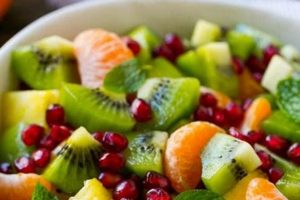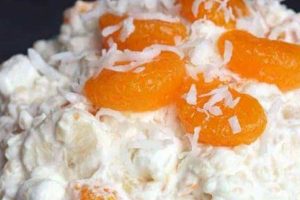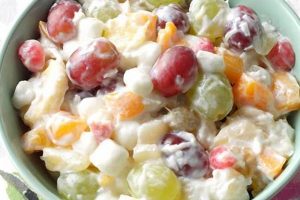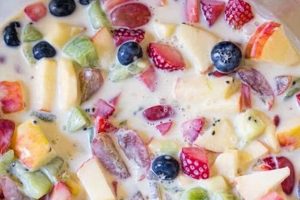A classic American dessert, this dish typically features a base of citrus fruits (often oranges and grapefruit segments) and shredded coconut. Sweet additions like maraschino cherries, miniature marshmallows, and pineapple chunks contribute to its characteristically rich flavor and texture. Variations may also include the use of other fruits, whipped cream, or nuts.
This refreshing dessert’s popularity stems from its balanced sweetness and contrasting textures. The juicy citrus provides a tartness offset by the sweetness of the other ingredients and the chewiness of the coconut. Its origins can be traced back to the late 19th century, becoming a staple at holiday gatherings and celebrations. The simplicity of its preparation coupled with its elegant presentation makes it a perpetually appealing option.
Further exploration of this culinary delight will encompass detailed recipes, regional variations, and tips for achieving optimal flavor and texture.
Tips for Ambrosia Fruit Salad Success
Creating a truly exceptional ambrosia fruit salad involves attention to detail and an understanding of flavor balances. These tips offer guidance on ingredient selection and preparation techniques for optimal results.
Tip 1: Citrus Selection is Key: Opt for firm, juicy citrus fruits. Peak-season produce yields the best flavor and texture. Consider a variety of citrus types for complex flavor profiles.
Tip 2: Precise Fruit Preparation: Carefully segment citrus fruits to remove all membrane, ensuring a pleasant texture. Freshly grated coconut is preferable to pre-shredded varieties for enhanced flavor.
Tip 3: Balancing Sweetness: The sweetness of additions such as marshmallows and maraschino cherries should complement the citrus, not overpower it. Adjust quantities based on personal preference and the natural sweetness of the fruit.
Tip 4: Maceration Considerations: Allowing the fruit mixture to rest for a short period, ideally chilled, allows the flavors to meld and the fruit to absorb the sweetness of any added sugar. Avoid excessive maceration, which can lead to a mushy texture.
Tip 5: Creative Ingredient Incorporation: While traditional recipes provide a foundation, experimentation with ingredients such as pecans, grapes, or bananas can add unique dimensions to the flavor profile.
Tip 6: Presentation Matters: Serve chilled in attractive bowls or individual glasses. Garnish with fresh mint sprigs or toasted coconut flakes for an elegant touch.
Tip 7: Storage Recommendations: Store leftover ambrosia fruit salad in an airtight container in the refrigerator for up to two days. Note that the texture may soften slightly over time.
By following these guidelines, one can achieve a well-balanced, flavorful, and visually appealing ambrosia fruit salad suitable for any occasion.
With a thorough understanding of the nuances of this classic dessert, exploration of recipe variations and cultural adaptations becomes even more rewarding.
1. Fresh, Ripe Citrus Fruits
Fresh, ripe citrus fruits form the foundation of a traditional ambrosia fruit salad. Their importance extends beyond mere inclusion; they dictate the overall flavor profile and textural experience. The selection of citrus significantly influences the balance between sweetness and acidity, a defining characteristic of this dessert. Employing in-season, juicy fruits like oranges and grapefruits ensures optimal flavor and a pleasant, refreshing tartness. Underripe or overly mature citrus can result in an unbalanced final product, lacking the vibrancy associated with ambrosia. For example, a mealy orange will contribute an undesirable texture and muted flavor, while an excessively tart grapefruit may overpower the other ingredients.
Beyond oranges and grapefruits, other citrus varieties offer unique flavor nuances. Mandarins lend a delicate sweetness, while blood oranges contribute a dramatic color and slightly more complex flavor profile. The choice of citrus allows for customization and tailoring the ambrosia to individual preferences. Consider using a combination of citrus types to create a layered flavor experience. The interplay between different levels of acidity and sweetness elevates the ambrosia beyond a simple fruit mixture. Adding segments of a particularly sweet orange alongside tart grapefruit sections allows for a complex and dynamic flavor profile within each bite.
Proper preparation of the citrus is also paramount. Careful segmenting, removing all pith and membrane, contributes to a refined texture. Leaving these components intact can introduce bitterness and detract from the overall enjoyment. The structural integrity of the fruit segments is also essential. While gentle handling preserves the fruit’s shape, excessive squeezing can release excess juice, resulting in a watery salad. Achieving a balance between a clean, segmented fruit and maintaining its structural integrity is key to a successful ambrosia. Ultimately, the quality and preparation of the citrus fruits directly impact the final quality and enjoyment of the traditional ambrosia fruit salad.
2. Sweet Additions (Marshmallows)
The inclusion of marshmallows in traditional ambrosia fruit salad contributes significantly to its characteristic sweetness and textural complexity. Marshmallows, typically the miniature variety, offer a soft, pillowy texture that contrasts with the juiciness of the citrus and the chewiness of the coconut. Their sweetness balances the tartness of the fruit, creating a harmonious flavor profile. This balancing act is crucial; the marshmallows should complement the inherent fruit flavors rather than overshadow them. Historically, the addition of marshmallows likely stemmed from a desire to enhance sweetness prior to widespread refrigeration, when achieving optimal ripeness in fruit could be challenging. Furthermore, the availability of commercially produced marshmallows in the late 19th and early 20th centuries coincided with the rise in popularity of ambrosia salad, making them a readily accessible ingredient.
The quantity of marshmallows used can be adjusted to suit individual preferences, but moderation is key. Too few marshmallows might not provide sufficient sweetness to balance the tartness, while an excess can lead to an overly sweet and cloying salad. Furthermore, the marshmallows’ ability to absorb moisture from the surrounding fruit can impact the overall texture. Prolonged exposure to the fruit’s juices can cause the marshmallows to become overly soft or even dissolve, affecting both the appearance and the mouthfeel of the salad. Recipes often recommend adding the marshmallows shortly before serving to maintain their distinct texture and prevent them from dominating the dish. This delayed addition also preserves the visual appeal of the individual marshmallows.
In summary, marshmallows play a multifaceted role in traditional ambrosia fruit salad, contributing sweetness, textural contrast, and a historical element. Careful consideration of quantity and timing ensures their contribution enhances the overall experience without overwhelming the other components. The balance achieved through the judicious inclusion of marshmallows highlights the thoughtful construction of this classic dessert. Their presence underscores the evolution of culinary practices and the adaptation of recipes to ingredient availability and evolving tastes.
3. Shredded Coconut
Shredded coconut forms an integral part of traditional ambrosia fruit salad, contributing texture, flavor, and visual appeal. Its presence is often considered a defining characteristic, distinguishing ambrosia from other fruit salads. Understanding its role requires exploration of various facets, from its historical inclusion to its impact on the overall sensory experience.
- Textural Contrast:
Shredded coconut provides a chewy counterpoint to the softer textures of the fruit and other ingredients like marshmallows. This textural contrast enhances the eating experience, adding complexity and preventing the salad from becoming monotonous. The slightly firm, yet yielding nature of the coconut complements the juicy segments of citrus and the smooth creaminess of additions like whipped cream or yogurt. This interplay of textures is crucial to the overall appeal of ambrosia.
- Flavor Enhancement:
The distinct, slightly sweet and nutty flavor of coconut enhances the overall flavor profile of the ambrosia salad. It complements the sweetness of other ingredients while providing a unique depth that sets it apart from simpler fruit mixtures. The choice between sweetened and unsweetened coconut allows for further flavor customization, catering to individual preferences and balancing the sweetness levels of other components like citrus fruits and marshmallows. Furthermore, toasting the coconut can intensify its flavor and introduce a subtle caramelized note.
- Visual Appeal:
The bright white color of shredded coconut against the vibrant hues of the fruit creates a visually appealing contrast, enhancing the presentation of the ambrosia salad. The delicate strands of coconut also add visual texture, making the dish more inviting. This visual element contributes to the perception of freshness and lightness, aligning with the refreshing nature of the dessert. Using different grades of shredded coconut, from fine to coarse, can also influence the final presentation.
- Historical Significance:
The inclusion of coconut in ambrosia likely reflects the ingredient’s growing availability in the United States during the late 19th and early 20th centuries, coinciding with the rise in popularity of the salad itself. This addition speaks to the adaptability of recipes and the incorporation of novel ingredients into established culinary traditions. Coconut, once considered exotic, became a symbol of abundance and celebration, further solidifying its place in this festive dessert.
The multifaceted role of shredded coconut in traditional ambrosia fruit salad underscores its significance beyond a mere ingredient. Its contribution to texture, flavor, visual appeal, and historical context elevates the dish to a more complex and nuanced culinary experience. Understanding these facets provides a deeper appreciation for the carefully balanced composition of this classic dessert.
4. Creamy Component (Whipped Cream/Yogurt)
The creamy component, often whipped cream or yogurt, plays a crucial role in traditional ambrosia fruit salad, contributing richness, texture, and flavor balance. This addition transforms the salad from a simple fruit mixture into a decadent dessert. The creaminess coats the other ingredients, binding them together and creating a more cohesive sensory experience. It softens the contrasting textures of the fruit and coconut, creating a smoother mouthfeel. Furthermore, the subtle tang of whipped cream or the slight tartness of some yogurts can balance the sweetness of the other components, creating a more complex flavor profile. For instance, the richness of whipped cream complements the bright citrus notes and the sweetness of marshmallows, while the tang of Greek yogurt can provide a refreshing counterpoint to the sweetness of canned fruit.
Historically, the inclusion of a creamy element likely evolved alongside refrigeration technology. Whipped cream, while achievable manually, became significantly easier to produce with chilled tools and ingredients. This coincided with the increasing popularity of ambrosia salad in the late 19th and early 20th centuries. The addition of readily available dairy products enriched the dish, transforming it into a more luxurious dessert. Regional variations emerged, with some recipes incorporating sour cream or crme frache, reflecting local ingredient availability and culinary traditions. These variations demonstrate the adaptability of ambrosia and its capacity to incorporate diverse creamy elements while maintaining its core identity.
Understanding the function of the creamy component is essential for achieving the desired balance and texture in ambrosia fruit salad. Selecting the appropriate type and quantity of the creamy element depends on the desired level of richness and the sweetness of the other ingredients. Overuse can result in a heavy, overly rich salad, while too little may not provide the desired creaminess and binding effect. The choice between whipped cream and yogurt offers further customization based on dietary preferences and desired flavor profiles. Ultimately, the creamy component elevates traditional ambrosia fruit salad from a simple fruit mixture to a more complex and satisfying dessert, reflecting the evolution of culinary practices and ingredient accessibility.
5. Optional Nuts, Spices
While not strictly traditional, the incorporation of nuts and spices offers opportunities to enhance the complexity and personalize the flavor profile of ambrosia fruit salad. These additions, though optional, provide textural and aromatic dimensions that elevate the classic dessert. Careful selection and application of these ingredients are crucial for achieving a harmonious balance without overwhelming the core elements of the fruit salad.
- Nuts: Textural and Flavor Enhancement
Nuts such as pecans, walnuts, or slivered almonds introduce a satisfying crunch and subtle richness. Toasted pecans provide a buttery, slightly sweet flavor that complements the fruit and coconut, while walnuts offer a more earthy, robust note. The choice of nut should complement the existing flavors without overpowering the delicate balance of sweetness and tartness. For example, the intense flavor of black walnuts may not harmonize as well as the milder pecan.
- Spices: Aromatic Complexity
A judicious touch of spice can add warmth and depth. Ground nutmeg or cardamom can enhance the sweetness of the fruit, while a pinch of cinnamon introduces a familiar warmth. These additions should be used sparingly to avoid overpowering the delicate flavors of the fruit and coconut. For instance, a heavy hand with cinnamon can easily mask the citrus notes, disrupting the intended flavor profile.
- Balancing Flavors
The key to successful incorporation of nuts and spices lies in understanding their impact on the overall balance of the ambrosia. The quantity used should complement, not compete with, the existing flavors. Consider the existing sweetness and tartness of the fruit when selecting spices. A sweeter fruit blend may benefit from the warm notes of spices like nutmeg, while a tarter mix might be enhanced by the addition of toasted, slightly sweet nuts.
- Regional Variations and Preferences
Regional variations of ambrosia salad often incorporate specific nuts or spices, reflecting local culinary traditions and ingredient availability. Some Southern variations feature pecans, a staple nut in the region, while others might include a hint of ginger or allspice. These regional adaptations demonstrate the versatility of ambrosia and its capacity to incorporate diverse flavor profiles while maintaining its core identity.
The thoughtful inclusion of nuts and spices provides an opportunity to personalize traditional ambrosia fruit salad. By understanding the interplay of flavors and textures, these optional additions can elevate the classic dessert, adding depth and complexity while respecting its traditional foundation. These customizations demonstrate the evolution of culinary traditions and the adaptability of recipes to individual preferences and regional influences.
6. Chilling Time
Chilling time is a crucial element in traditional ambrosia fruit salad preparation, significantly impacting the final flavor and texture. This chilling period allows the flavors of the various componentscitrus fruits, coconut, marshmallows, and any additional ingredientsto meld and harmonize. The low temperature slows down enzymatic activity within the fruit, preserving its fresh flavor and preventing excessive softening. Furthermore, chilling allows the flavors of added sweeteners, whether from the marshmallows, canned fruit, or additional sugar, to permeate the fruit, resulting in a more evenly distributed sweetness. For instance, the coconut absorbs the citrus juices and becomes more flavorful, while the marshmallows soften slightly, contributing to a more cohesive texture. Without sufficient chilling, the ambrosia may taste disjointed, with individual flavors competing rather than complementing one another. The texture may also be less appealing, with distinct layers rather than a unified blend.
The practical implications of understanding the role of chilling time are substantial. Chilling for an adequate period, typically at least two hours, allows the ambrosia to reach its optimal flavor and texture. This pre-serving chill also enhances the refreshing quality of the dish, making it particularly appealing in warmer weather. Over-chilling, however, can lead to undesirable textural changes. The fruit may become overly soft, and the marshmallows may lose their distinct shape. Finding the optimal chilling time, typically between two and four hours, allows the flavors to meld while preserving the integrity of the individual components. This balance is key to achieving the desired textural and flavor complexity that defines traditional ambrosia fruit salad.
In conclusion, chilling time is not merely a preparatory step but a crucial component in achieving the balanced flavors and desirable texture characteristic of traditional ambrosia fruit salad. Understanding the impact of temperature and time on the interaction of ingredients ensures a more successful and enjoyable culinary experience. The balance between sufficient chilling for flavor development and avoiding over-chilling for texture preservation highlights the nuanced approach required for creating a truly exceptional ambrosia fruit salad. This attention to detail distinguishes a thoughtfully prepared ambrosia from a simple mixture of ingredients.
7. Elegant Presentation
Elegant presentation elevates traditional ambrosia fruit salad from a simple dish to a visually appealing dessert suitable for special occasions. While the flavor profile remains paramount, the visual aspect contributes significantly to the overall perception and enjoyment. A thoughtfully presented ambrosia reflects care and attention to detail, enhancing the dining experience. This connection between presentation and perception stems from the psychological impact of visual aesthetics on appetite and perceived value. An attractively arranged salad appears more appetizing and is often perceived as being of higher quality, even if the ingredients are identical to a less carefully presented version. For example, serving ambrosia in a clear glass bowl showcases the vibrant colors of the fruit and the contrasting textures, stimulating visual interest and anticipation.
Several factors contribute to an elegant presentation. Choosing appropriate serving vessels is crucial. Crystal bowls or individual stemmed glasses lend an air of sophistication. Garnishing with fresh mint sprigs or toasted coconut flakes adds visual interest and complements the flavors. Careful arrangement of the fruit and other components also plays a role. Rather than simply tossing the ingredients together, a more deliberate arrangement showcases the variety of colors and textures. Consider placing segments of different citrus fruits in a visually appealing pattern or creating layers of fruit, coconut, and cream. These small details elevate the presentation and create a more refined dessert experience. For a festive occasion, consider using cookie cutters to shape the fruit or adding edible flowers for a touch of elegance. These techniques add visual appeal without compromising the traditional flavor profile.
The practical significance of elegant presentation extends beyond mere aesthetics. It communicates value and consideration to guests, enhancing their overall dining experience. A beautifully presented ambrosia suggests that time and effort have been invested, transforming a simple dessert into a more memorable occasion. While the core recipe remains the foundation, attention to presentation elevates the ambrosia, aligning it with celebratory contexts and enhancing its perceived value. Understanding this connection allows for a more nuanced approach to preparing and serving traditional ambrosia fruit salad, demonstrating a mastery of both culinary skill and presentation artistry. This combination of flavor and aesthetics solidifies ambrosia’s enduring appeal as a classic dessert suitable for a variety of occasions.
Frequently Asked Questions
This section addresses common inquiries regarding the preparation and enjoyment of traditional ambrosia fruit salad.
Question 1: What is the origin of the name “ambrosia”?
The term “ambrosia” originates from Greek mythology, referring to the food of the gods, believed to confer immortality. The application of this name to the fruit salad likely stems from its perceived deliciousness and rich combination of ingredients.
Question 2: Can canned fruit be used in traditional ambrosia?
While fresh fruit is preferred for optimal flavor and texture, canned fruit, particularly mandarin oranges and pineapple, can be used. Ensure the fruit is well-drained to prevent excess liquid from watering down the salad.
Question 3: How long can ambrosia fruit salad be stored?
Ambrosia fruit salad is best consumed within two days of preparation. Store it in an airtight container in the refrigerator to maintain freshness and prevent oxidation. The texture may soften slightly over time.
Question 4: Can alternative sweeteners be used instead of marshmallows?
While marshmallows are traditional, alternative sweeteners like honey or maple syrup can be used. Adjust the quantity to achieve the desired level of sweetness, keeping in mind that these alternatives may alter the overall flavor profile.
Question 5: What are common variations on the traditional recipe?
Variations include the addition of nuts like pecans or walnuts, different types of citrus fruits, and the incorporation of spices such as nutmeg or cinnamon. Some recipes also include a creamy component like whipped cream or yogurt.
Question 6: Is ambrosia fruit salad appropriate for individuals with dietary restrictions?
Traditional ambrosia can be high in sugar. Adjustments, such as using alternative sweeteners or reducing the quantity of marshmallows, can be made to accommodate specific dietary needs. Consult nutritional information for specific ingredients to ensure compliance with dietary restrictions.
These responses aim to provide a comprehensive understanding of common queries related to traditional ambrosia fruit salad. Consideration of these points ensures successful preparation and enjoyment of this classic dessert.
Further exploration of recipe variations and historical context can enhance appreciation for this enduring culinary tradition.
Traditional Ambrosia Fruit Salad Recipe
Exploration of this classic dessert reveals a carefully balanced composition of flavors and textures. From the foundational citrus base to the nuanced sweetness of marshmallows and the textural interplay of shredded coconut, each component contributes to the ambrosia’s enduring appeal. Careful consideration of ingredient selection, preparation techniques, and chilling time ensures optimal flavor development and textural balance. Optional additions of nuts and spices offer opportunities for personalized variations while respecting the traditional foundation. Elegant presentation further enhances the dining experience, elevating this simple fruit salad to a dessert worthy of special occasions. Understanding the historical context and cultural significance deepens appreciation for this culinary tradition.
Traditional ambrosia fruit salad represents more than a mere combination of ingredients; it embodies a culinary heritage passed down through generations. Continued exploration of regional variations and adaptations promises to unveil further nuances and enrich appreciation for this timeless dessert. This ongoing culinary conversation ensures the preservation and evolution of a cherished classic, inviting both seasoned cooks and newcomers to experience the delightful complexity of traditional ambrosia fruit salad.






